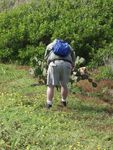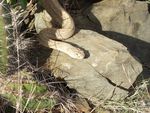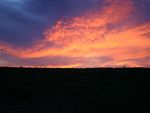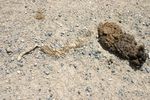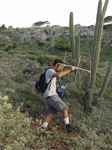The Ecology and Conservation of the Aruba Island Rattlesnake, Crotalus unicolor.
←
→
Page content transcription
If your browser does not render page correctly, please read the page content below
The Ecology and Conservation of the Aruba Island
Rattlesnake, Crotalus unicolor.
Howard K. Reinert1, Lauretta M. Bushar2, and R. Andrew Odum3
1Department of Biology, The College of New Jersey, Ewing, NJ
2Department of Biology, Arcadia University, Glenside, PA
3Department of Herpetology, Toledo Zoological Society, Toledo, OHDuring this time period 57 snakes were monitored with radiotelelemetry for periods of up to 3 years.
These efforts resulted in 3,656 telemetrically-assisted observations of the ecology and behavior of free-ranging Aruba Island Rattlesnakes.
The current distribution of the Aruba Island Rattlesnake
encompasses 76 km2 of the 175 km2 island.
Noord N
150 m
100 m
Oranjestad 50 m
Santa Fontein
Cruz
Hooiberg (166 m) Formerly Described
Range
Current Range
Jamanota (189 m)
Savaneta
San Nicolas
2 km
Punta BasoraPrincipal Components Analysis of Structural Habitat Variables
Habitat Variable First Principal
Component
Foliage Density to 1 m 0.905
Foliage Density to 2m 0.766
Distance to Cacti 0.118
Distance to Woody Plants -0.275
Distance to Rocks 0.464
Canopy Closure 0.604
% Surface Vegetation 0.836
% Rock Cover -0.386
% Leaf Litter Cover 0.388
% Soil Exposed -0.599Habitat Use by Aruba Island Rattlesnakes
MALE
RANDOM
FEMALE
INCREASING SURFACE VEGETATION AND CANOPY
INCREASING EXPOSED SOIL AND ROCKPreferred Habitat of Aruba Island Rattlesnakes
Spatial Statistics for Aruba Island Rattlesnakes
Mean Total Mean Distance Minimum
Sex Distance Moved Moved/Day Convex Polygon
(m) (m) Area (ha)
Male 2021.0 26.1 8.4
(n = 30) (±314.43) (±5.04) (±2.46)
Female 1142.6 11.2 3.4
(n = 27) (±194.05) (±3.18) (±0.53)
• Males demonstrated significantly larger values for all
spatial parameters (P < 0.05).
• Values of spatial parameters are approximately half that
exhibited by Timber Rattlesnakes in Pennsylvania.Movement patterns of a female and a male Aruba Island
Rattlesnake
BEL58 – female
n = 59 days
Total distance = 889 m
Distance/day = 16.2 m
Convex Polygon Area = 1.85 ha
BEL74 – male
n = 98 days
Total distance = 4212 m
Distance/day = 43.0 m
Convex Polygon Area = 22.1 haActivity range and movement pattern of a female Cascabel (BEL5) over 316 days (8/14/93 – 6/26/94).
Activity range of a male Cascabel (BEL3) over 312 days (8/6/93 – 6/14/94) and locations over the next two years.
Translocation of 500 m had little impact on behavior.
BEL98 - translocated
BEL98 - nativeThe Diet of the Aruba Island Rattlesnake
Prey Number Percent
Aruban Whiptail Lizard 14 42.4%
House Mouse 8 24.2%
Cottontail Rabbit 4 12.1%
Bird 3 9.1%
Vesper Mouse 2 6.1%
Black Rat 2 6.1%Foraging positions:
Often associated with
flowering and fruiting bushes
or trees and sometimes…
a dead goat.Does the Aruba Island Rattlesnake has a chance for
survival?Arikok National Park (35 km2) was established in 1997.
It contains nearly half of the habitat occupied by the
Aruba Island Rattlesnake.
Noord N
150 m
100 m
Oranjestad 50 m
Santa Fontein
Cruz Arikok National
Hooiberg (166 m)
Park Boundary
Current Range
Jamanota (189 m)
Savaneta
San Nicolas
2 km
Punta BasoraProtection of rattlesnakes and restoration of habitat needs to
be a primary goal in Park management.Annual mortality of adult Cascabels based upon the Trent
and Rongstad Estimator and a 365 day active season.
SAMPLE NUMBER TOTAL ANNUAL
GROUP SIZE DEAD RADIO-DAYS* MORTALITY
Males 14 4 2838 40.2%
Females 14 8 2633 67.1%
Overall 28 12 5471 55.1%
*1 Radio-day = 1 snake monitored for 1 dayIdentified Causes of Mortality
Vehicles*
8.3%
Goats &
Donkeys* Malnutrition
16.7% 41.7%
Humans*
25.0% Unknown
8.3%
*50% of Cascabel mortality can be reduced or eliminated!Controllable Sources of Rattlesnake Mortality Traffic-related mortality Mortality due to feral goats and donkeys Degradation of habitat by feral livestock Purposeful killing and collecting by humans
Goats and Donkeys Kill Rattlesnakes
and Degrade the Habitat
Populations need to be reduced
or eliminated within the Park.Killed by:
Donkey
GoatRoads are Dangerous for the Cascabel
•Cascabels do not avoid roads
•They are slow-moving
•They often stop moving when
a car approachesThe Result:
Reduce Road Mortality
Strictly enforce a low speed limit.
Restrict vehicular traffic (including ATVs) to
limited areas of the Park.
Close all park roads to unauthorized vehicles after
sunset and before sunrise.
Post road signs at regular intervals along all park
roads:
“SLOW - WILDLIFE CROSSING”Awareness Will Help
SLOW
WILDLIFE
CROSSINGEducation also needs to be a major part of the
conservation program for CascabelsEducate and Inform
Post regulations at park entrances and interior locations
(trailhead parking areas, caves, beaches)
“It is illegal to disturb, harass, remove, or kill any
animal or plant within the Park”
Create Brochures/Guides
-regulations guide
-wildlife and plant identification guides
-history, natural history and geology information
sheets
Training Programs for Park rangers/private tours
guides.Aruba Snake Brochure
SANTANERO BOA CASCABEL
(Leptodeira bakeri) (Boa constrictor) (Crotalus unicolor)
The slender Santanero or Aruban Cat-eyed Boas are Aruba’s largest snakes. The The small Cascabel or Aruba Island
Snake is typically less than 50 cm long. This longest Boa found on the island was slightly Rattlesnake averages 70 cm in length. The
snake is recognizable by the large scales on less than 3 m. Newborn Boas average 35 cm. body color is often uniform gray or light
the top of its head and by its pattern of dark Boas are not venomous. The most distinctive brown. There may be a faint pattern of
brown bands alternating with light brown feature of a Boa is its pattern of dark brown diamond shaped markings on the back. This
bands. The belly is plain white or cream and tan blotches which become red toward pattern is most noticeable on younger
colored without any markings. the tail. The belly in white or cream colored snakes. The most distinctive feature of this
This snake is shy and not aggressive. with numerous black spots. snake is the rattle at the end of its tail which
However, it has enlarged teeth at the back Boas are excellent climbers and may be makes a buzzing sound when the snake is
of its mouth and mild venom which is not found in trees and cactus. Boas also hide in alarmed.
dangerous to humans. However, the venom the leaves under bushes waiting to catch Cascabels are shy and not aggressive, but
can paralyze small lizards and frogs. prey that pass. Boas catch their prey with their venom can be dangerous to humans. It
Santaneros are most active at night when their teeth and then constrict it in their is best to leave this snake alone. Do not
they search for food. During the day, they coils. The Boa’s diet consists of birds, attempt to catch or kill it.
hide under rocks or leaves. They frequently lizards, rats, mice, and rabbits. Large Boas Cascabels hunt by waiting under bushes
climb trees and cactus. Santaneros eat toads, have been known to eat small goats and and fruiting trees to catch passing lizards,
frogs, insects, and lizards. chickens. When threatened, Boas will hiss mice, rats, small rabbits, and an occasional
You may find Santaneros near dams loudly. bird.
during periods of rainy weather or crossing Boas are a non-native species. The first This is often considered to be one of the
roads at night. This snake is found island Boas were reported on the island in 1999. rarest rattlesnakes in the world. The range of
wide. Since that time they have been found across the Cascabel is restricted to the rugged and
the entire island in all types of habitats. mountainous areas of the island mostly
within Arikok National Park.Monitoring and Research • Establish a long-term monitoring program • Respond to Cascabel sightings • Relocate reported Cascabels – short distance translocation is safe • Continue basic research
Especially - Assess the threat of the invasive Boa Constrictor to the Cascabel and other native fauna. Can they live together on “One Happy Island”?
Acknowledgements
Field Biologists:
Gian L. Rocco, Zach Felix, Mike Torroco, Matt McCort,
Robert Rupert, Jr., Jan Piet Bekker, Robert Smit, Diego
Marquez, and Matt Goode
Logistic support:
Aruba Department of Agriculture, Husbandry and Fisheries: T.
Barmes, S. Vrolijk, T. Damian, P. Portier, F. Franken
Arikok National Park: D. Arrends, A. Cruiel, S. Franken, R. de
Kort, E. Croes
Aruba Veterinaire Dienst: E. de Cuba, P. Barendsen, T. Wools
Funding support:
American Association of Zoological Parks and Aquaria, Coastal
Oil Corporation, ESSO Petrolera, S.A., MetaCorp, the Toledo
Zoological Society, and the College of New Jersey.• Our research continues. • After 15 years, this is only end in sight.
Thank you.
Questions?You can also read

